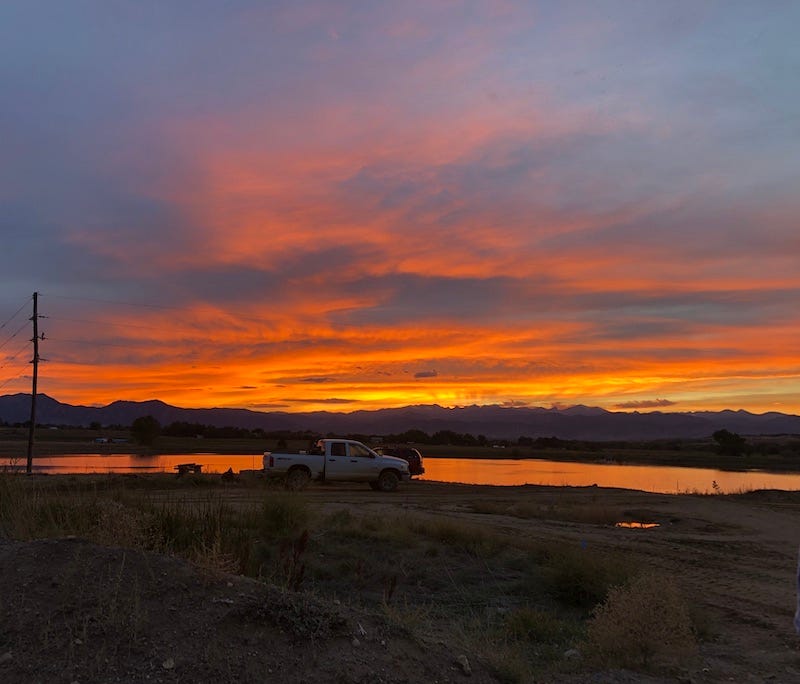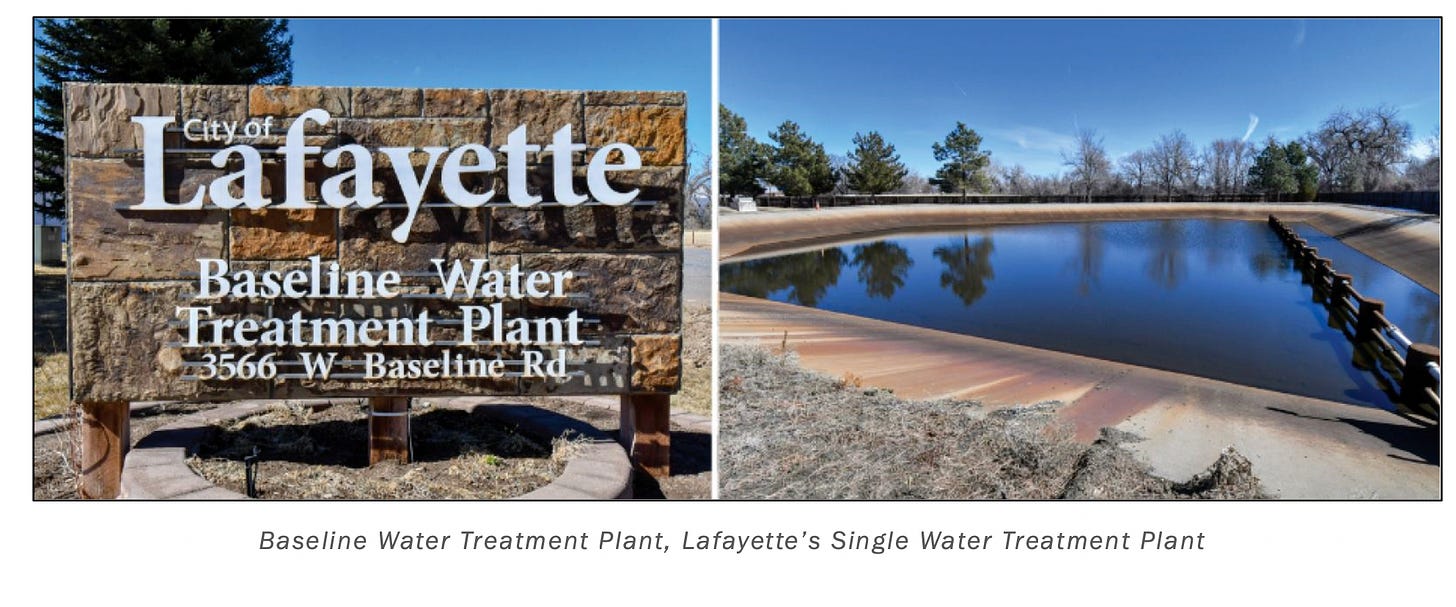Following the Money - Part Six B - 2nd water treatment plant, golf course irrigation, road and bridge repairs
The second batch of potential projects

As I explained in Following the Money - Part 6A - New pool, city hall, expanded service center or public safety complex? in September the city council toured some potential big-ticket items. In a future meeting they will discuss whether to move forward with any of them and how to provide funding.
I purposefully broke the projects into two posts. Funding for projects in the first group will likely require the voters to weigh in. This group is different. We go back to something I have written about in the past. Enterprise Funds! If you’ve been reading my posts you know all about this. (pop quiz coming later, stop reading now!) But here’s a quick rundown.
ENTERPRISE FUNDS
We have five enterprise funds, the golf course, waste management, and three water utility funds: water, water reclamation, and stormwater. You can see four of the funds listed on your water bill. When you pay your bill the money you owe is directed into these specific funds.
The waste management fund receives your trash solid-waste payment which goes to Republic and isn’t mingled into our general fund. The same is true for the other funds, no mingling allowed.
I always use the golf course to explain enterprise funds so why change now? These funds are run like a business. If you go to the golf course and play a round of golf, shop in the store, or have lunch, that money goes into the fund to support the course. The course is supported by the users, not Lafayette taxpayers. If the course is short of money the city can’t just put a pot load of money into the fund, it’s not allowed. The same is true for the water funds. Any improvements or repairs needed for each water facility must come from its own dedicated fund, powered by the users.
The increased water rates we have seen over the last year or so reflect the problem of not having enough money in the funds to deal with needed repairs etc. You can see from this series of water reports that I have been working to keep you informed about what’s been happening. Short version, we need a lot of stuff and we don’t have the funds to pay for it.
ENTERPRISE FUNDS - THE FUNDING DIFFERENCE
What makes the next two projects different from those in part one, is that the voters don’t approve any bonding needed to pay for improvements or expansions, the city has the authority to do it.
Before we look at the two potential projects a quick comment from my soap box.
For years and years I have been pointing out that rooftops don’t pay for themselves. When we add additional dwelling units to the city the rest of us end up on the hook for the increase in required city services. From water and city facilities to fire and police, growth costs the residents money. I point to the first sentence in the following piece as exhibit Q “Significant additional water treatment capacity is needed to reliably serve current demands and projected buildout.”
The tour included a visit to the Goose Haven Reservoir Complex where we store part of our water supply before sending it off to be treated and then to your faucet. Staff pointed out that we own land in this complex and it’s a potential site for a new water treatment plant. We arrived just as the sun was setting, a Great Blue Heron flew overhead, and a coyote chorus was happening nearby.
A SECOND WATER TREATMENT PLANT
From the staff report:
Project Overview
Significant additional water treatment capacity is needed to reliably serve current demands and projected buildout. Additional capacity is proposed to be achieved through construction of a second facility, separate from the existing Baseline Water Treatment Plant, in order to optimize resilience, reliability, and operational flexibility.
A site selection process is underway in 2024. Site alternatives will be discussed with City Council in Q3-Q4 2024. Design is anticipated to start in 2025. Construction will require debt financing through issuance of bonds by the water utility enterprise.
Expenses
· 2024 Revised Budget – $1,500,000
· 2025 Recommended Budget – $2,000,000
· Future Expenses (Anticipated) – Construction costs will be determined through the design process and included in a future budget. The new facility will have long term operating, preventative maintenance, and replacement costs. Long term expenses will be considered through the site selection and design process.
GOLF COURSE IRRIGATION
From the staff report:
The irrigation system at the Indian Peaks Golf Course is 33 years old, and components are beginning to fail at an increasing rate, causing reduced efficiency and increased water usage. Leaks have been difficult to detect resulting in longer-term water loss. Replacement of the Golf Course irrigation system would allow the City to install a more efficient irrigation technology and reduce the number of leaks, water-loss associated with leaks, and the amount of staff-time spent searching for and repairing leaks. Modernized irrigation system would allow for more precise and coordinated watering as well as asset mapping on installation for easier leak detection and repairs.
This project can be handled in phases or all at once with an estimated completion time of 6 – 12 months. A phased approach would allow for golf operations to continue during installation.
Expenses
· 2024 Revised Budget – $0
· 2025 Recommended Budget – $0
· Future Expenses (Anticipated) – $6,500,000
ASPHALT AND CONCRETE REHABILITATION PROGRAM
From the staff report:
The City’s multimodal transportation system includes over 120 miles of roadway, including asphalt and concrete pavement, concrete curb and gutter; and over 200 miles of concrete sidewalk. Asphalt and concrete have a limited lifespan and require periodic repair, rehabilitation, and replacement. A variety of treatments are used with the intent optimize lifespan and minimize costs. Asphalt rehabilitation projects generally require bringing adjacent sidewalks and ramps up to current federal standards (Americans with Disabilities Act, or ADA) including providing colored/textured truncated domes and directionalized ramps to provide accessibility for people that are visually impaired and ensuring that widths, slopes and transitions accommodate mobility needs.
The City has historically spent approximately $2.6M per year on the annual asphalt and concrete program with additional expenditures for temporary patching and repair of damaged sidewalks. Funding levels have not been regularly increased to account for construction cost escalation or compliance with ADA. As a result, the miles of work that can be completed have steadily decreased over time. This is exacerbated by how asphalt deteriorates over time. Treatments such as crack sealing and chip sealing can extend pavement life at costs of $12,000 to $88,000/mile. Once a street deteriorates to the point of needing the surface ground off and repaved, the costs jumps to approximately $220,000/mile. The current funding gap is resulting in more and more streets deteriorating to the point of requiring full reconstruction at a cost of approximately $1,200,000/mile. Deteriorated streets also result in significant costs for pothole repair and patching. At current funding levels, the City would not complete the 5-year plan developed in 2020 until 2033 even if no additional pavement deterioration occurred. Staff’s current estimate is that funding levels would need to double and then escalate annually with construction costs to achieve a sustainable trajectory for the program. That estimate will continue to increase as rehabilitation is deferred and more streets require full reconstruction.
Expenses
· 2024 Revised Budget – $2,600,000
· 2025 Recommended Budget – $2,600,000
· Future Expenses (Anticipated) – Approximately $11,900,000 is programmed into the City’s Capital Improvement Plan through 2029, although additional funding will be necessary to meet backlog
120TH COAL CREEK BRIDGE AND UNDERPASS
From the staff report:
The Colorado Department of Transportation (CDOT) is responsible for providing inspections of “off-system” bridges owned and maintained by local communities. CDOT’s inspection of the City’s bridge over 120th Street at Coal Creek identified significant concerns, and the City has been directed to repair or replace the bridge as soon as possible. Failure to address CDOT’s concerns could result in a requirement that the bridge be closed to traffic or imposition of weight restrictions that could substantially impact access to Lafayette industries and related heavy vehicle traffic. The bridge provides access to the eastern portion of Lafayette, including Peak to Peak Charter School, the Boulder Valley School District bus barn, multiple industrial businesses with heavy vehicle traffic, and the future Willoughby Corner affordable housing development. Design has included an extensive alternatives analysis including repair and replacement options and measures to address floodplain constraints at this location. Construction is anticipated to begin in Q1 2025, and the total net cost is estimated to be approximately $900,000 after grant reimbursements.
Expenses
· 2024 Revised Budget – $751,327
· 2025 Recommended Budget – Additional $663,438 ($513,000 reimbursable through grant)
· Future Expenses (Anticipated) – None
That’s it for the potential projects we saw on the tour. I’ll be back to wrap up the 2025 budget process soon!
Want to offer more support? Awesome!








Karen –
In your introductory paragraph you say, “If you go to the golf course and play a round of golf, shop in the store, or have lunch, that money goes into the fund to support the course. The course is supported by the users, not Lafayette taxpayers.” … but then later, in the golf course irrigation description, you say, “Replacement of the Golf Course irrigation system would allow the City to install a more efficient irrigation technology and reduce the number of leaks, water-loss associated with leaks, and the amount of staff-time spent searching for and repairing leaks.” Does that mean taxpayers would be paying for the golf course irrigation upgrade?
Thank you for your reporting!
Cindy Beeler
Thank you so much for doing this. Do you know if they have selected the part of town where the 2nd treatment plant would go yet?